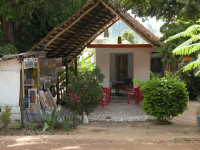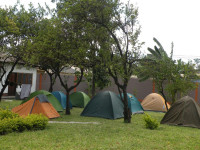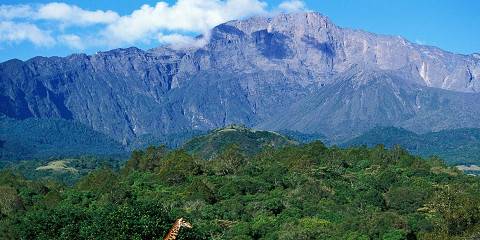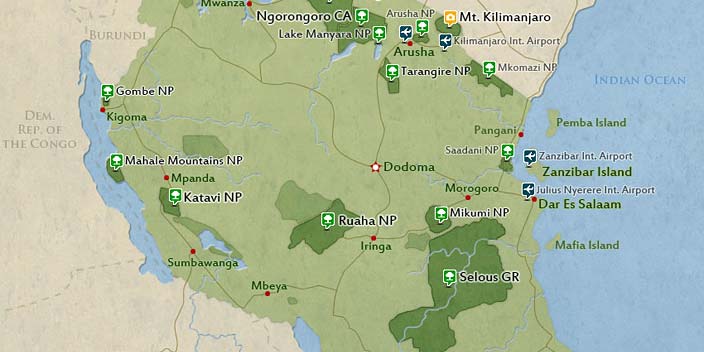
Arrival
Arrival

Day 1
Tarangire National Park
Tarangire National Park
In the morning you will start your safari with a driver to Tarangire National Park. The park has roughly the size of Luxemburg, covers an area of approximately 2,600 km². The landscape of savannah, seasonal swamps and giant baobab trees is home to Masai giraffes, buffaloes, hartebeest, eland, fringe-eared oryx, the weird-looking long-necked gerenuk and over 550 species of birds. Tarangire is famous park, is probably one of the best places in East Africa to see them and to get close to these giant creatures. After an extensive game drive, you will arrive at a campsite, where you will spend the night in a tent.
- Main Destination:
- Tarangire National Park
- Accommodation:
- Fig Tree Lodge & Camp
- Meals & Drinks:

Day 2
Lake Manyara National Park
Lake Manyara National Park
After breakfast you will drive to the smaller Lake Manyara National Park. The park is known for its over 400 bird species, primate-filled forests and grassy plains. A large area of the park is covered by the alkaline Lake Manyara, which is home to colonies of flamingos and other water birds. Apart from elephants you might also spot giraffes, hippos, wildebeests, impalas and teeming groups of noisy monkeys and baboons in the forests near the lake. In the afternoon, after an extensive game drive, you will travel to the small multi-cultural village of Mto wa Mbu, on the outskirts of Lake Manyara National Park. You will camp at a campsite for the night.
- Main Destination:
- Lake Manyara National Park
- Accommodation:
- Fig Tree Lodge & Camp
- Meals & Drinks:

Day 3
Lake Manyara - Serengeti
Lake Manyara - Serengeti
Today you will continue to the lush highlands where crops such as wheat, corn and coffee are grown. While travelling through the Ngorongoro Conservation Area you might stop for a breath-taking view over the Ngorongoro Crater before continuing to the Serengeti National Park. Serengeti means “endless plains” in the language of the Maasai and you will see the grassland savannah stretching to the horizon. Bizarre rock formations called kopjes dot the grassy landscape where predators are often seen. Depending on the season you will witness the migration of thousands of animals for which this park is famous for. You will arrive at your campsite in the Seronera Valley in the central Serengeti in the late afternoon. After supper you will fall asleep to the sounds of the African bush.
- Main Destination:
- Serengeti National Park
- Accommodation:
- Budget camping
- Meals & Drinks:

Day 4
Serengeti National Park
Serengeti National Park
The whole day will be spent on a game drive in the Serengeti. The areas that you visit will depend upon where the migrating herds are (predators usually follow closely behind the trekking animals). During the short rainy season in November and December the herds move from the hills in the north to the plains in the south. During the longer rainy season from April to June they return up north. The yearly trek is determined by the rainfalls and the location of the herds might vary from year to year but your guide will know where to find the animals and where to see them best. Apart from wildebeests and zebras you might also spot predators such as lions, leopards and cheetahs. You will spend another night at a campsite in the Seronera area.
- Main Destination:
- Serengeti National Park
- Accommodation:
- Budget camping
- Meals & Drinks:

Day 5
Serengeti National Park - Ngorongoro National Park
Serengeti National Park - Ngorongoro National Park
After breakfast have another game drive in the Serengeti National Park. This morning you might spot animals you haven’t seen yet. The Serengeti is also home to the Big Five – lion, elephant, buffalo, rhino and leopard – and today you might be able to see all the members of this group. After lunch at a picnic site, you will drive in direction of the Ngorongoro Crater. As soon as you have reached the edge of the crater, the caldera opens up before you. Over 25,000 animals live in this approximately 20 km wide crater. You will spend the night at a campsite directly on the crater’s edge with fantastic views over the caldera.
- Main Destination:
- Ngorongoro Crater
- Accommodation:
- Budget camping
- Meals & Drinks:

Day 6
Ngorongoro Crater - Arusha
Ngorongoro Crater - Arusha
Rise and shine! After breakfast at daybreak you drive down into the crater. Inside the world’s largest caldera, you will see a diversity of wildlife ranging from black rhinos, Grant’s and Thomson’s gazelles, lions and leopards to elephants and mountain reedbucks in the forests on the slopes. You might also see buffaloes, spotted hyenas, rare wild dogs and some of the more than 500 bird species of the area. After an intensive game drive and a picnic lunch, you will leave the caldera in the afternoon and travel back to Arusha where you will arrive in the early evening.
- Main Destination:
- Ngorongoro Crater
- Accommodation:
- No accommodation (End of tour)
- Meals & Drinks:






















